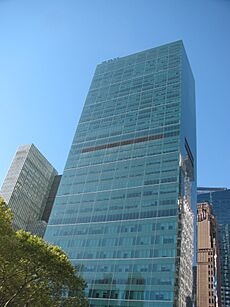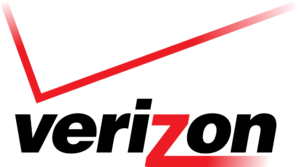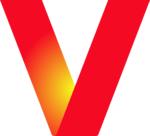Verizon facts for kids

Logo used since 2024
|
|

Headquarters in New York
|
|
|
Formerly
|
Bell Atlantic Corporation (1983–2000) |
|---|---|
| Public | |
| Traded as | |
| ISIN | [https://isin.toolforge.org/?language=en&isin=US92343V1044 US92343V1044] |
| Industry | Telecommunications |
| Predecessors |
|
| Founded | October 7, 1983 |
| Headquarters | 1095 Avenue of the Americas,
,
U.S.
|
|
Area served
|
United States |
|
Key people
|
Hans Vestberg (chairman & CEO) Tony Skiadas (EVP & CFO) |
| Products |
|
| Revenue | |
|
Operating income
|
|
| Total assets | |
| Total equity | |
|
Number of employees
|
99,600 (2024) |
| Divisions |
|
| Subsidiaries |
|
Verizon Communications Inc. is a big American company that provides many ways for people to communicate. It is based in New York City. Verizon is one of the largest telecommunications companies in the world. Its mobile network is the biggest wireless carrier in the United States, with over 146 million customers.
The company started in 1983 as Bell Atlantic. This happened when the original Bell System, a huge phone company, was broken up into smaller companies called "Baby Bells." Bell Atlantic was first located in Philadelphia. It served states like Pennsylvania, New Jersey, and Maryland.
In 1997, Bell Atlantic grew by joining with another "Baby Bell" called NYNEX. This merger moved the company's main office to New York City. Then, in 2000, Bell Atlantic bought GTE, which had phone companies in many other parts of the country. After this, Bell Atlantic changed its name to Verizon. The name Verizon comes from two words: veritas, which is Latin for "truth," and "horizon."
Verizon also expanded into owning online content. In 2015, it bought AOL, and in 2017, it bought Yahoo! Inc.. These companies became part of a new division called Oath Inc., which was later renamed Verizon Media. In 2021, Verizon sold most of its share in this media group, which was then renamed Yahoo! Inc..
Today, Verizon is one of only three companies left that came from the original "Baby Bells." The others are AT&T (which used to be SBC Communications) and Lumen Technologies (which used to be CenturyLink).
Contents
Verizon's Journey: A Look at Its History
How Verizon Started: Bell Atlantic and Early Mergers (1984–2002)
In 1983, the U.S. government decided to break up the large AT&T phone company. This led to the creation of Bell Atlantic Corporation in 1984. It was one of the first "Baby Bell" companies.
Bell Atlantic included several smaller phone companies. These were like The Bell Telephone Company of Pennsylvania and New Jersey Bell.
In 1996, Bell Atlantic joined with another "Baby Bell" called NYNEX. This merger brought New York Telephone and New England Telephone into the company. After this, Bell Atlantic moved its main office to New York City.
In April 2000, Bell Atlantic teamed up with a British company called Vodafone. They created Verizon Wireless as a joint company. Bell Atlantic owned 55% of this new mobile phone business, and Vodafone owned 45%. This deal was worth about $70 billion. It created a large mobile company with 23 million customers. Verizon Wireless combined the wireless networks of Bell Atlantic, Vodafone's AirTouch, and GTE's wireless division. This made Verizon Wireless a strong competitor because it could offer service across the whole country.
Bell Atlantic officially changed its name to Verizon Communications in June 2000. This happened after the government approved its $64.7 billion merger with GTE. The name Verizon combines the Latin word veritas (truth) and "horizon."
Verizon became the largest local phone company in the U.S. It had 63 million phone lines in 40 states. The company also gained 25 million mobile phone customers. Verizon also started offering internet and long-distance phone services.
In August 2000, about 85,000 Verizon workers went on an 18-day strike. This affected the company's earnings. Verizon launched its 3G mobile service in 2002. This service made internet speeds faster. In August 2002, Verizon began offering bundles of local, long-distance, mobile, and internet services.
Growing Bigger: Verizon's Expansion (2003–2010)
In April 2004, Verizon Communications was added to the Dow Jones Industrial Average. This is an important list of major companies in the stock market. Verizon replaced its competitor AT&T on this list.
Verizon started its Fios Internet service in 2004. Fios uses fiber optic cables to send data very quickly. In September 2005, Verizon launched Fios TV. By 2006, Fios offered many channels, including high-definition ones.
Starting in 2005, Verizon began to focus more on its mobile phone, internet, and TV services. It sold off some of its older landline phone businesses and international parts. For example, it sold phone lines in Hawaii in 2005. It also sold its phone directory business in 2006. In 2009, Verizon spun off many wireline services in several states to Frontier Communications. Verizon also sold its interests in phone companies in the Dominican Republic, Puerto Rico, and Venezuela.
In 2005, Verizon bought MCI, a company that provided long-distance phone services. This purchase was worth about $8.5 billion. It helped Verizon gain many business customers and expand into global markets. As a result, Verizon Business was created to serve companies and government clients.
In May 2006, it was reported that Verizon, along with other phone companies, had shared landline phone records with the National Security Agency (NSA) after the September 11 attacks. Verizon stated that it only fulfilled "lawful demands" for information.
Verizon won a lawsuit against Vonage in March 2007 for using its patented technology. Vonage was ordered to pay Verizon $120 million. In May 2007, Verizon bought CyberTrust, a company that provides internet security services.
In 2007, Verizon opened its networks to other companies' mobile apps and devices. This allowed it to take part in a big auction for wireless airwaves in 2008. Verizon won a large part of these airwaves for $9.4 billion. This helped Verizon improve its 4G service.
Verizon bought Rural Cellular Corp. for $2.7 billion in 2008. That same summer, Verizon announced it would buy wireless carrier Alltel for $28.1 billion. This acquisition added 13 million customers. It helped Verizon Wireless become the largest mobile carrier in the U.S., surpassing AT&T.
In October 2010, Verizon Wireless paid $77.8 million in refunds and penalties for overcharging 15 million customers for data services. Verizon said these overcharges were accidental.
Verizon launched its 4G LTE network in many cities in December 2010. The company planned to keep expanding this 4G service.
New Services and Growth (2011–Present)
In early 2011, Verizon bought Terremark, a company that provides information technology services, for $1.4 billion.
Ivan Seidenberg retired as Verizon's CEO on August 1, 2011. Lowell McAdam took over as the new CEO.
In June 2012, Verizon bought Hughes Telematics for $612 million. This company makes wireless features for cars. This was part of Verizon's plan to grow into new areas of its wireless business.
The government ruled in 2012 that Verizon could not charge extra fees for customers to use their 4G smartphones and tablets as Wi-Fi hotspots (also known as "tethering"). Verizon had been charging $20 per month for this service.
In September 2013, Verizon bought Vodafone's 45% share in Verizon Wireless for $130 billion. This deal was completed on February 21, 2014. It made Verizon Communications the sole owner of Verizon Wireless. This was one of the largest business deals ever.
In October 2014, Verizon Wireless launched a technology news website called SugarString. The site faced some issues when it was reported that its writers could not publish articles about net neutrality or government surveillance. The site was closed in December.
In August 2015, Verizon launched Hum. This service and device helps monitor and diagnose problems in vehicles. In 2016, Verizon bought Fleetmatics for $2.4 billion. This company helps manage vehicle fleets for businesses. Verizon also acquired Sensity, a company that makes LED sensors, to improve its IoT services.
In January 2017, Verizon added to its fiber-optic network and 5G capabilities. It completed a $1.8 billion purchase of XO Communications' fiber-optic network business. Verizon also made a deal with Corning Inc. to buy many miles of optical fiber.
In 2018, Verizon created Verizon Connect. This combined its Telematics, Fleetmatics, and Telogis units.
On December 10, 2018, Verizon announced that 10,400 managers chose to leave the company. This was part of a program offered to employees. At the same time, the company reported a $4.6 billion reduction in value for its media division.
Verizon made some big changes to its structure from 2018 to 2019. Hans Vestberg became the new CEO on August 1, 2018. His plan focused on Verizon's 5G technology. In early 2019, Verizon reorganized into three main parts: Consumer, Business, and Media.
Verizon started offering free anti-spam and robocalling features to all its customers in March 2019.
Verizon began rolling out its 5G mobile network in April 2019. By the end of that year, the network was active in 30 cities. Verizon uses special high-frequency waves for its 5G network. These waves allow for very fast speeds but have a limited range.
In January 2020, Verizon launched OneSearch, a search engine focused on privacy.
Verizon bought the videoconferencing service BlueJeans in May 2020. This helped Verizon expand its business offerings, especially for online meetings.
In September 2020, Verizon announced plans to buy TracFone Wireless for $6.25 billion. This deal was approved in November 2021.
In 2021, Verizon and AT&T delayed their 5G network rollout. This was because the service could potentially affect airplane safety systems. After discussions with the Federal Aviation Administration, they agreed on measures to activate 5G safely around airports.
Verizon greatly increased its mid-band spectrum holdings in early 2021. It bought C-Band spectrum for $52.9 billion at an FCC auction.
In December 2023, Verizon announced plans to open a new center in Limerick, Ireland. This center will create over 400 jobs in technology and communications.
In May 2024, Verizon announced a partnership with AST SpaceMobile. This will help improve cellular and broadband access in remote areas using satellites.
On September 5, 2024, Verizon announced its plan to buy Frontier in a $20 billion deal. This acquisition aims to expand Verizon's fiber network. The Federal Communications Commission approved this acquisition on May 16, 2025.
Buying AOL and Yahoo
Verizon bought AOL in 2015 for about $4.4 billion. The next year, Verizon announced it would buy the main internet business of Yahoo! for $4.83 billion. After these purchases, Verizon created a new division called Oath. This division included the AOL and Yahoo brands.
Verizon completed its purchase of Yahoo for $4.48 billion on June 13, 2017.
In 2021, Verizon sold its media group, which included AOL and Yahoo, to Apollo Global Management for $5 billion. Verizon kept a 10% share in this division.
Verizon's Financial Health
For the year 2024, Verizon reported earnings of $17.95 billion. Its total yearly income was $134.788 billion. Verizon's shares were worth over $45 each, and the company's total value was over $163.96 billion in January 2025. Verizon is ranked #31 on the Fortune 500 list for 2023. This list includes the largest companies in the U.S.
Where Verizon Operates
Verizon offers internet, traditional landline phone, VoIP (phone service over the internet), home security, pay television, and web hosting services. These services are available in nine states in the eastern United States.
Key areas where Verizon operates include:
- Delaware
- Maryland (like Baltimore and Salisbury)
- Massachusetts (like Boston)
- New Jersey
- New York (like New York City, Albany, and Buffalo)
- Pennsylvania (like Harrisburg, Philadelphia, and Pittsburgh)
- Rhode Island (like Providence)
- Virginia (like Norfolk and Richmond)
- Washington, DC
How Verizon Reaches Customers: Marketing Campaigns
Verizon Communications has used several marketing campaigns to connect with its customers.
Can You Hear Me Now?
The "Can you hear me now?" campaign started in 2001 for Verizon Wireless. It featured an actor named Paul Marcarelli as "Test Man." He traveled around the country asking, "Can you hear me now?" This campaign ran until 2010. It helped Verizon Wireless gain many new customers.
There's a Map for That
The "There's a map for that" campaign began in late 2009. It made fun of AT&T's "There's an app for that" campaign. The ads showed maps comparing Verizon's network coverage to AT&T's.
Who Leads Verizon: Corporate Governance
As of 2024, the main leaders at Verizon are:
- Hans Vestberg: He is the chairman and CEO (Chief Executive Officer).
- Sowmyanarayan Sampath: He leads Verizon Consumer.
- Kyle Malady: He leads Verizon Business.
Being a Good Neighbor: Corporate Responsibility
Verizon gives money to organizations through its charity group, The Verizon Foundation. The company also had a program called HopeLine. This program provided mobile phones to people affected by domestic violence. Verizon also supports education through programs like Verizon Innovative Learning Schools. These programs help children learn about STEM (Science, Technology, Engineering, and Math).
Between 2019 and 2023, Verizon issued five "green bonds." These bonds raised $5 billion. The money from the 2023 bond was used to help switch to more environmentally friendly electricity.
In 2020, Verizon launched its "Citizen Verizon" plan. This plan includes goals for social and environmental responsibility. One goal is for Verizon to be completely carbon neutral by 2035. The plan also offers digital skills training for young people.
Verizon's Support for Sports and Entertainment
Verizon sponsors many sports teams, events, and venues.
National Hockey League
In January 2007, Verizon became a special marketing partner with the National Hockey League. This deal was extended in 2012. It allowed Verizon to offer special content through its GameCenter app.
Motorsports
Verizon sponsored Justin Allgaier in the NASCAR Nationwide Series in 2009 and 2010. In March 2014, Verizon became the main sponsor of the IndyCar Series until 2018.
Verizon also sponsored a NASCAR Cup Series race in 2021. This was the Verizon 200 at the Brickyard.
National Football League
In late 2010, Verizon Communications partnered with Vodafone Group. They became the official wireless partner of the National Football League. This deal was worth about $720 million. In June 2013, Verizon extended its deal with the NFL for another four years. This new agreement, worth about $1 billion, gave Verizon the right to stream every NFL regular-season and playoff game.
USA Team Handball
In January 2020, Verizon became a founding partner of USA Team Handball. They are the jersey sponsor for the U.S. men's and women's national handball teams. They also sponsor the USA Team Handball College Nationals.
2026 FIFA World Cup
In September 2024, Verizon announced it would be a sponsor for the 2026 FIFA World Cup. This major soccer event will be held in the United States, Canada, and Mexico. Verizon will provide cellular network access for fans at stadiums and fan events.
Venues
The main concert hall for the Philadelphia Orchestra is named Verizon Hall.
Verizon used to sponsor several sports and entertainment arenas. These included Simmons Bank Arena in Arkansas and the Mayo Clinic Health System Event Center in Minnesota. Verizon also sponsored entertainment amphitheaters in places like Irvine, California, and Alpharetta, Georgia.
Verizon is a former sponsor of the Capital One Arena in Washington, DC.
See also
 In Spanish: Verizon Communications para niños
In Spanish: Verizon Communications para niños
- Verizon strike of 2016
- List of United States telephone companies





